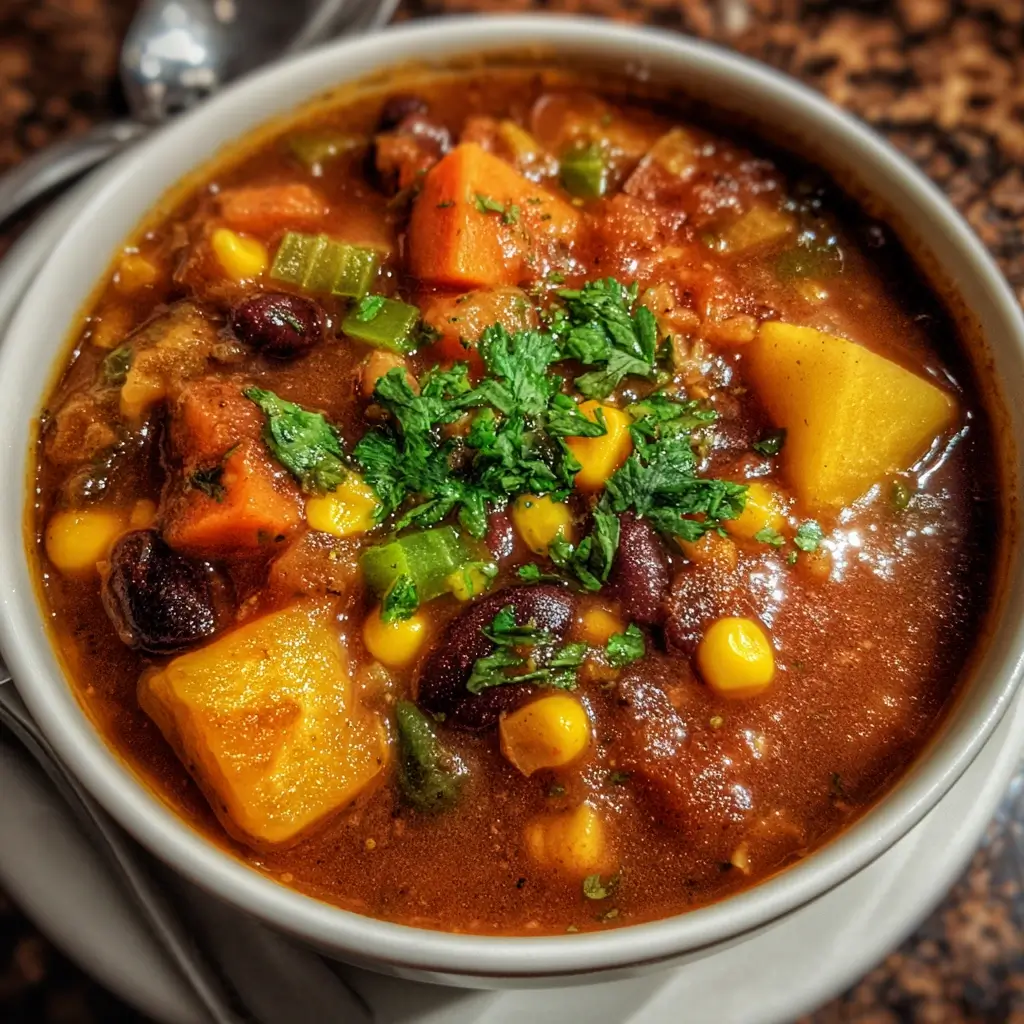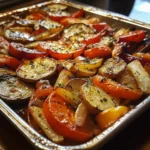The first time I made Three Sisters Stew, it was a cool, crisp autumn evening. The leaves outside were turning brilliant shades of gold and crimson, and the air had that specific, earthy scent of impending winter. I wanted a meal that felt like a warm hug in a bowl, something deeply nourishing and connected to the season. As the trinity of corn, beans, and squash simmered on my stovetop, the kitchen filled with an aroma that was at once simple and profound. It smelled of the earth, of history, and of home. When my family gathered around the table, ladles of the vibrant, colorful stew filling their bowls, the reaction was immediate. It wasn’t just the delicious, savory-sweet flavor that captivated them; it was the feeling of comfort and wholesomeness. We talked about the story behind the name, the cleverness of ancient agricultural practices, and how incredible it is that three simple ingredients can create such a complete and satisfying meal. That evening, this stew became more than just dinner; it became a story we shared, a new tradition, and a beloved fixture in our cold-weather recipe rotation.
The Enduring Legacy of the Three Sisters: More Than a Meal
Before we dive into the pot, it’s essential to understand the beautiful and profound story behind this stew’s name. The “Three Sisters” is not just a quaint title; it’s a reference to a cornerstone of Indigenous American agriculture and culture, particularly among the Haudenosaunee (Iroquois) people, but practiced by many tribes across North America. It represents a sophisticated, sustainable, and symbiotic system of companion planting that has nourished communities for centuries. This isn’t just a recipe; it’s a taste of history, ingenuity, and a deep respect for the land.
The Symbiotic Trio: How They Grow Together
The genius of the Three Sisters lies in how they support and sustain one another in the field, creating a robust and self-sufficient ecosystem.
- The Corn (The Elder Sister): The corn is planted first. It grows tall and strong, providing a natural pole or trellis for the bean vines to climb. It stands as the structural support for the entire system.
- The Beans (The Giving Sister): Planted next, the bean vines wind their way up the sturdy corn stalks, reaching for the sunlight without competing for ground space. Crucially, the beans are nitrogen-fixers. They pull nitrogen from the air and convert it into a form in the soil that the corn, a heavy feeder, desperately needs to thrive.
- The Squash (The Protective Sister): Finally, the squash is planted at the base. Its large, sprawling leaves spread across the ground, acting as a living mulch. This shades the soil, preventing weeds from growing, keeping the ground cool and moist, and deterring pests with its prickly vines.
This agricultural marvel ensured a reliable and diverse food source. When eaten together, these three ingredients also form a nutritionally complete meal, providing complex carbohydrates (corn), essential amino acids and protein (beans), and a wealth of vitamins and healthy fats (squash).
A Story of Sustenance and Spirit
The Three Sisters are more than just a clever farming technique; they are deeply woven into the spiritual and cultural fabric of many Native American communities. They are seen as precious gifts from the Great Spirit, to be respected, celebrated, and shared. The story of the three sisters who are inseparable and always look after one another is a powerful metaphor for community, cooperation, and the interconnectedness of all living things. Making this stew is a way to honor that tradition and connect with a philosophy of living in harmony with the earth.
The Heart of the Matter: The Complete Three Sisters Stew Recipe
This version of the Three Sisters Stew is hearty, flavorful, and deeply satisfying. It balances the sweetness of the squash and corn with the earthiness of the beans and a savory, lightly spiced broth. It’s a forgiving recipe, so feel free to adjust to your taste.
Ingredients You’ll Need
- For the Stew:
- 2 Tablespoons Olive Oil or Avocado Oil
- 1 large Yellow Onion, chopped
- 2 large Carrots, chopped
- 2 Celery Stalks, chopped
- 4 cloves Garlic, minced
- 1 medium Butternut Squash (about 2-3 pounds), peeled, seeded, and cut into 1-inch cubes
- 6 cups Vegetable Broth (low sodium)
- 1 (28-ounce) can Fire-Roasted Diced Tomatoes, undrained
- 1 (15-ounce) can Kidney Beans, rinsed and drained
- 1 (15-ounce) can Pinto Beans or Black Beans, rinsed and drained
- 2 cups Frozen Corn (fire-roasted if available)
- 1 teaspoon Smoked Paprika
- 1 teaspoon Cumin Powder
- 1/2 teaspoon Dried Thyme
- 1/4 teaspoon Chili Powder (or more, to taste)
- 2 Bay Leaves
- Salt and freshly ground Black Pepper to taste
- For Garnish (Optional):
- Fresh Cilantro, chopped
- Toasted Pumpkin Seeds (Pepitas)
- A dollop of Sour Cream or Plain Greek Yogurt (or a vegan alternative)
- A squeeze of fresh Lime Juice
Step-by-Step Instructions
- Prepare the Flavor Base: In a large Dutch oven or heavy-bottomed pot, heat the olive oil over medium heat. Add the chopped yellow onion, carrots, and celery (this trio is known as a mirepoix). Sauté for 8-10 minutes, stirring occasionally, until the vegetables have softened and the onion is translucent. This step is crucial for building a deep, savory foundation for your stew.
- Bloom the Aromatics: Add the minced garlic, smoked paprika, cumin, dried thyme, and chili powder to the pot. Stir constantly for about 1 minute until fragrant. This process, called “blooming,” toasts the spices and unlocks their full flavor potential.
- Simmer the Squash: Pour in the vegetable broth and the undrained fire-roasted tomatoes. Add the cubed butternut squash and the bay leaves. Stir everything together, scraping up any browned bits from the bottom of the pot. Bring the mixture to a boil, then reduce the heat to low, cover the pot, and let it simmer for 15-20 minutes, or until the squash is tender enough to be easily pierced with a fork. Be careful not to overcook it into mush; you want the cubes to hold their shape.
- Introduce the Other Sisters: Once the squash is tender, stir in the rinsed and drained kidney beans, pinto beans, and the frozen corn. Increase the heat to medium and bring the stew back to a gentle simmer.
- Final Simmer and Season: Let the stew cook, uncovered, for another 10-15 minutes. This allows the flavors to meld together and the stew to thicken slightly. Remove the bay leaves. Taste the stew and season generously with salt and freshly ground black pepper. Don’t be shy with the seasoning; a well-seasoned stew is a delicious stew.
- Rest and Serve: Turn off the heat and let the stew rest for at least 5-10 minutes before serving. This allows the flavors to settle and deepen even further. Ladle the hot stew into bowls and top with your favorite garnishes.
At a Glance: Nutrition and Timing
Understanding the nutritional value and time commitment helps you plan your meal perfectly.
Nutrition Facts
- Servings: 8
- Serving Size: Approximately 1.5 cups
- Calories per serving: Approximately 350 kcal
- Please note that this is an estimate. Actual nutrition will vary based on the specific ingredients, brands, and optional additions used. This stew is an excellent source of dietary fiber, plant-based protein, Vitamin A (from the squash and carrots), and complex carbohydrates.
Preparation & Cook Time
- Preparation Time: 20 minutes (for chopping vegetables and peeling/cubing squash)
- Cook Time: 50-60 minutes
- Total Time: Approximately 1 hour and 15 minutes
How to Serve Your Three Sisters Stew: A Canvas for Creativity
This stew is wonderfully complete on its own, but serving it with the right accompaniments and garnishes can elevate it from a simple meal to a memorable feast. Here’s how to present it for maximum enjoyment:
- The Classic Bowl:
- Ladle the stew into deep, rustic ceramic bowls to emphasize its earthy, comforting nature.
- Add a swirl of full-fat sour cream, Greek yogurt, or a dollop of vegan cashew cream for a touch of tangy richness that cuts through the sweetness of the squash.
- Sprinkle generously with fresh, chopped cilantro or parsley for a burst of bright, herbaceous flavor and color.
- Add a Little Crunch:
- Texture is key! Top each bowl with a spoonful of roasted and salted pumpkin seeds (pepitas). This not only adds a delightful crunch but also pays homage to the squash component of the trinity.
- Crumbled tortilla chips or crispy fried onions also provide a wonderful textural contrast.
- Bread for Dipping:
- No stew is complete without something to sop up the delicious broth. Serve with a side of:
- Warm Cornbread: The ultimate pairing. The slightly sweet, crumbly cornbread is the perfect companion.
- Crusty Sourdough Bread: For a more rustic, European-style accompaniment.
- Native American Fry Bread: For a truly traditional and indulgent experience.
- No stew is complete without something to sop up the delicious broth. Serve with a side of:
- A Touch of Acidity:
- Serve each bowl with a lime wedge on the side. A final squeeze of fresh lime juice right before eating brightens all the flavors and adds a zesty finish that balances the entire dish.
Pro Tips for the Perfect Stew: Elevating Your Dish
Take your Three Sisters Stew from great to unforgettable with these five expert tips.
1. The Squash Switch-Up
While butternut squash is a fantastic and readily available choice due to its sweet flavor and creamy texture, don’t be afraid to experiment with other winter squashes.
- Kabocha Squash: This Japanese pumpkin has a fluffy, chestnut-like texture and a sweet, earthy flavor that is incredible in this stew. You don’t even need to peel it, as the skin becomes tender when cooked.
- Acorn Squash: Milder and slightly more fibrous than butternut, acorn squash holds its shape well and adds a lovely visual element.
- Sugar Pumpkin: For a classic autumnal flavor, a small sugar pumpkin (not a carving pumpkin) is a perfect substitute.
2. Bean Basics: Dried vs. Canned
Canned beans are a fantastic time-saver, but if you have the time, using dried beans will reward you with superior flavor and texture.
- To use dried beans: You’ll need about 1 cup of dried beans to equal two 15-ounce cans. Soak them overnight in plenty of water. The next day, drain and rinse them, then cook them separately in fresh water or broth until tender before adding them to the stew at the same step you would add canned beans. Cooking them with a bay leaf and a clove of garlic adds extra flavor.
3. Building a Deeper Flavor Base
The secret to any amazing stew lies in its base. Don’t rush the first step.
- The “Fond”: When you sauté the onions, carrots, and celery, allow them to stick to the bottom of the pot slightly and develop a brown glaze. This is called “fond,” and it’s packed with flavor. When you add the broth, be sure to scrape all of those browned bits off the bottom—this process, known as deglazing, infuses the entire stew with a rich, caramelized taste.
- Umami Boost: For an even deeper, more savory flavor, consider adding a tablespoon of tomato paste along with the garlic and spices, or a teaspoon of miso paste or soy sauce stirred in at the end.
4. Let It Rest (The Flavor Meld)
This tip is simple but transformative. Like many stews and soups, Three Sisters Stew is even better the next day. The flavors need time to meld, marry, and deepen. If you can, make it a day ahead of when you plan to serve it. Reheat it gently on the stovetop, and you’ll be rewarded with a much more complex and harmonious dish.
5. Storing for the Future: Meal Prep Gold
This stew is a meal prepper’s dream. It freezes beautifully.
- Refrigeration: Store cooled stew in an airtight container in the refrigerator for up to 5 days.
- Freezing: Let the stew cool completely. Ladle it into freezer-safe containers or heavy-duty freezer bags, leaving about an inch of headspace for expansion. It will keep well in the freezer for up to 3 months. To reheat, thaw it overnight in the refrigerator and then gently warm it on the stovetop, adding a splash of broth or water if it has thickened too much.
Your Three Sisters Stew Questions, Answered
Here are answers to some of the most common questions about making this historic and hearty stew.
1. Can I make this stew with meat?
Absolutely. While the vegetarian version is traditional and nutritionally complete, this stew is very adaptable. For a heartier, non-vegetarian meal, consider these additions:
- Shredded Chicken: Add 2 cups of pre-cooked, shredded chicken (rotisserie chicken works well) during the last 10 minutes of simmering.
- Ground Turkey or Bison: Brown 1 pound of ground meat with the onions at the beginning of the recipe, breaking it up with a spoon. Drain any excess fat before proceeding. Bison, in particular, adds a rich flavor that complements the stew’s earthy notes.
- Smoked Sausage: Add sliced, pre-cooked smoked sausage, like andouille or kielbasa, along with the beans and corn for a smoky, savory kick.
2. How can I make this a truly vegan Three Sisters Stew?
This recipe is naturally very close to being vegan. To ensure it is 100% vegan, just follow these simple steps:
- Broth: Use a certified vegan vegetable broth.
- Oil: Ensure you are using a plant-based oil like olive oil or avocado oil.
- Garnishes: For the creamy topping, use a vegan sour cream alternative, a dollop of unsweetened coconut yogurt, or a homemade cashew cream instead of dairy-based sour cream or yogurt.
3. Is Three Sisters Stew considered healthy?
Yes, it is exceptionally healthy. It’s a powerhouse of nutrition.
- Fiber: The combination of beans, squash, and vegetables makes it incredibly high in dietary fiber, which is essential for digestive health and helps you feel full and satisfied.
- Plant-Based Protein: The beans provide a significant amount of protein, making it a complete meal without the need for meat.
- Vitamins and Minerals: Butternut squash is loaded with Vitamin A and Vitamin C. The beans offer iron and magnesium, and the corn provides B vitamins.
- Low in Fat: It is naturally low in saturated fat, especially when prepared as a vegetarian or vegan dish.
4. Can I make this in a slow cooker or Instant Pot?
Yes, this stew adapts wonderfully to both appliances.
- Slow Cooker Instructions: Sauté the onion, carrots, celery, garlic, and spices in a skillet on the stovetop as directed. Transfer this mixture to the slow cooker. Add the squash, broth, and tomatoes. Cook on low for 6-8 hours or on high for 3-4 hours, until the squash is tender. Stir in the beans and corn during the last 30 minutes of cooking. Season to taste before serving.
- Instant Pot Instructions: Use the “Sauté” function to cook the onion, carrots, celery, garlic, and spices directly in the Instant Pot. Add the squash, broth, and tomatoes. Secure the lid, set the valve to “Sealing,” and cook on high pressure for 8 minutes. Perform a quick release of the pressure. Stir in the beans and corn, and use the “Sauté” function again for a few minutes to heat them through. Season to taste.
5. What is the main difference between this and other vegetable stews?
The primary difference is the intentional and culturally significant combination of the “Three Sisters”: corn, beans, and squash. While many vegetable stews might contain one or two of these, a Three Sisters Stew specifically celebrates this trio as the star ingredients. Its historical and agricultural backstory sets it apart, making it more than just a random assortment of vegetables. The flavor profile is also distinct—often a balance of the squash’s sweetness, the corn’s pop, and the beans’ creamy earthiness, all in a simple, savory broth that lets the core ingredients shine.
Print
Native American Three Sisters Stew Recipe
Ingredients
- For the Stew:
- 2 Tablespoons Olive Oil or Avocado Oil
- 1 large Yellow Onion, chopped
- 2 large Carrots, chopped
- 2 Celery Stalks, chopped
- 4 cloves Garlic, minced
- 1 medium Butternut Squash (about 2–3 pounds), peeled, seeded, and cut into 1-inch cubes
- 6 cups Vegetable Broth (low sodium)
- 1 (28-ounce) can Fire-Roasted Diced Tomatoes, undrained
- 1 (15-ounce) can Kidney Beans, rinsed and drained
- 1 (15-ounce) can Pinto Beans or Black Beans, rinsed and drained
- 2 cups Frozen Corn (fire-roasted if available)
- 1 teaspoon Smoked Paprika
- 1 teaspoon Cumin Powder
- 1/2 teaspoon Dried Thyme
- 1/4 teaspoon Chili Powder (or more, to taste)
- 2 Bay Leaves
- Salt and freshly ground Black Pepper to taste
- For Garnish (Optional):
- Fresh Cilantro, chopped
- Toasted Pumpkin Seeds (Pepitas)
- A dollop of Sour Cream or Plain Greek Yogurt (or a vegan alternative)
- A squeeze of fresh Lime Juice
Instructions
- Prepare the Flavor Base: In a large Dutch oven or heavy-bottomed pot, heat the olive oil over medium heat. Add the chopped yellow onion, carrots, and celery (this trio is known as a mirepoix). Sauté for 8-10 minutes, stirring occasionally, until the vegetables have softened and the onion is translucent. This step is crucial for building a deep, savory foundation for your stew.
- Bloom the Aromatics: Add the minced garlic, smoked paprika, cumin, dried thyme, and chili powder to the pot. Stir constantly for about 1 minute until fragrant. This process, called “blooming,” toasts the spices and unlocks their full flavor potential.
- Simmer the Squash: Pour in the vegetable broth and the undrained fire-roasted tomatoes. Add the cubed butternut squash and the bay leaves. Stir everything together, scraping up any browned bits from the bottom of the pot. Bring the mixture to a boil, then reduce the heat to low, cover the pot, and let it simmer for 15-20 minutes, or until the squash is tender enough to be easily pierced with a fork. Be careful not to overcook it into mush; you want the cubes to hold their shape.
- Introduce the Other Sisters: Once the squash is tender, stir in the rinsed and drained kidney beans, pinto beans, and the frozen corn. Increase the heat to medium and bring the stew back to a gentle simmer.
- Final Simmer and Season: Let the stew cook, uncovered, for another 10-15 minutes. This allows the flavors to meld together and the stew to thicken slightly. Remove the bay leaves. Taste the stew and season generously with salt and freshly ground black pepper. Don’t be shy with the seasoning; a well-seasoned stew is a delicious stew.
- Rest and Serve: Turn off the heat and let the stew rest for at least 5-10 minutes before serving. This allows the flavors to settle and deepen even further. Ladle the hot stew into bowls and top with your favorite garnishes.
Nutrition
- Serving Size: One Normal Portion
- Calories: 350





